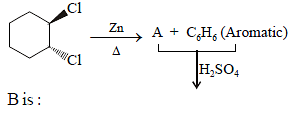Aromatic Hydrocarbons - 1 - JEE MCQ
30 Questions MCQ Test - Aromatic Hydrocarbons - 1
which of the following compounds will react with NH2Θ under normal circumstances?
Nitrobenzene can be prepared from benzene by using a mixture of conc. HNO3 and conc. H2SO4. In the mixture, nitric acid acts as a/an?
| 1 Crore+ students have signed up on EduRev. Have you? Download the App |
Phenyl isocyanides are prepared from which of the following reaction ?
Which of the following is most reactive in SNAr reaction?
Observe the following transformation

X & Y for best yield is

Product P is known as “Phenacetin”, an analgesic. What is the structure of P ?
Assertion : In Nitration of chlorobenzene, the major product is m-nitrochlorobenzene
Reason : –NO2 group is a m-directing group.
Passage I
An aromatic hydrocarbon P has molecular formula C9H12. P on treatment with alkaline KMnO4 in boiling condition followed by hydrolysis gives polar C8H6O4 . Also, P on treatment with CI2/AICI3 gives only two isomers Q and R as major products with their molecular formula C9H11CI
Q. If all the monochloro isomers of P are considered, how many of them are possible?
Passage II
Consider the following road-map reaction,
Q. The most likely structure of P is
Direction (Q. Nos. 21 and 22) Choices for the correct combination of elements from Column I and Column II are given as options (a), (b), (c) and (d), out of which one is correct.
Q. Match the reactions from Column I with expected products from Column II.
Match the reactions from Column I with expected product(s) from Column II.

















































